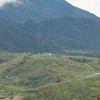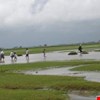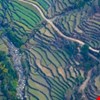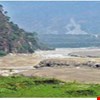
In Kazakhstan, the issue is not one of scarcity but of management, a problem that can be solved through applying the principles of IWRM. The government of Kazakhstan consequently initiated a water resources management project aiming at strengthening water management organisations and by instituting the practice of IWRM. In this process, training, workshops and dialogues both within and outside the water sector are crucial.

In Kyrgyzstan, lack of drinking water and access to sanitation is a pressing problem which reinforces social vulnerability and poverty. Financed by the Asian Development Bank and the World Bank, actions have been taken to improve access to drinking water and sanitation by the Ministry of Health. These projects had a high level of community involvement which increased the sense of ownership.

Lao People’s Democratic Republic (PDR) faces considerable challenges in the delivery of sustainable and equitable access to sanitation in rural areas. Small steps have been taken towards increasing national ownership of and political commitment to sanitation in Lao PDR. As a lesson learnt; there is no one blueprint for progress in sanitation delivery. Services can be delivered in different ways– e.g. household investment or direct programmatic efforts.

The development of hydropower in the Mekong River basin can bring great economic opportunities for Laos. However, since this basin is shared with neighbouring countries, cooperation is crucial. Action was taken and the Agreement on the Cooperation for the Sustainable Development of the Mekong River Basin was signed to coordinate the use of these resources for economic development. For Laos, this has been crucial to their success in regards to the MDGs.

The district of Cameron Highlands is subjected to a range of environmental problems, ranging from landslides, mudslides, erosion, siltation to water woes. Action was taken by the WWF advocating sustainable highland development to safeguard Cameron Highlands’ delicate ecosystem. Furthermore, through community initiative, the Regional Environmental Awareness of Cameron Highlands was created. This case highlights the value of cooperation between NGOs and community initiatives.

Clearing for logging, combined with expanding agriculture and palm oil plantations has led to increased flooding, and pollution of the Kinabatangan River due to pesticides and fertilizers. Working in partnership, the Sabah Wildlife Department and the WWF took action and have established the Lower Kinabatangan Wildlife Sanctuary. The key lesson of this case is the value of starting with small-scale feasible projects before scaling up.

To increase agricultural productivity, the Ministry of Agriculture and Irrigation has encouraged many farmers to organise water users groups. Yields are to be increased through the collaborative and efficient participation of beneficiary farmers engaged in irrigation. This has led to efficient water distribution throughout the managed watercourse. The most important lesson learnt is the importance of the strengthening of each water user group.

The Khimti 1 Hydropower Project was initiated to increase hydropower supply in Nepal. Action was taken to carry out an Environmental Impact Assessment to identify promotion of livelihood, economic enhancement and social well being of the project area communities. The project formulated an Environmental Monitoring Plan as well as environmental mitigation and monitoring programme. The key lesson to learn is the importance of assessment prior to the development of any project.

International donors have poured money into developing Nepal’s irrigation infrastructures since the late-1950s, but results remain only partly successful. At present, irrigation infrastructures have been developed to serve 1.331 million ha but the irrigation potential is estimated to about 1.76 million ha. The Irrigation Water Resources Management Project is one of the latest international aid efforts aimed to developing the irrigation facilities while improving Nepal’s institutional framework pertaining to water infrastructure projects. The importance of adequate and timely finance, well-defined administrative roles and institutional capacity building are part of the key lessons learned from this project.

Nepal is particularly vulnerable to climate change impacts for a variety of environmental, social, and economic reasons. Average temperatures have been rising steadily since the 1970s. Most of the mountain ranges within Nepal are home to extensive glaciers which are experiencing widespread retreat. Glacial discharge in turn impacts the hydrological regimes of rivers downstream and causes rapid growth of glacial lakes; glacier lake outburst floods (GLOFs) are one of many climate change phenomena with the potential to pose extreme risk to populations, infrastructure, etc.